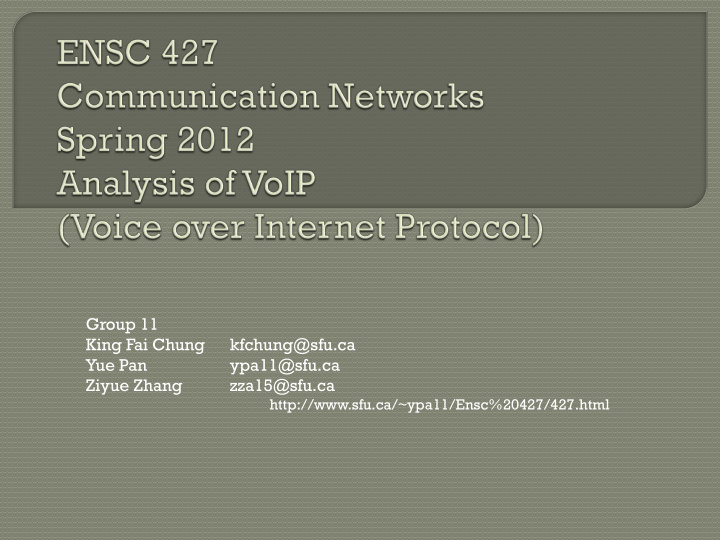



Group 11 King Fai Chung kfchung@sfu.ca Yue Pan ypa11@sfu.ca Ziyue Zhang zza15@sfu.ca http://www.sfu.ca/~ypa11/Ensc%20427/427.html
Introduction Scenario cases Results analysis
Start 1970s Transmit voice and multimedia over packet switched network Operate Over Internet Protocol Alternative to public switched telephone network (PSTN) Allows call to be make over non phone device
Cost Quality Reliability
Project motivation • Increasing popularity of VoIP Project overview • Performance of VoIP between wire and wireless connection • Compare and analysis the QoS parameter between scenarios
Scenario Two location Two- Floor locate across Office Canada Ethernet Local Lan Wlan Local Wlan with Wlan Long Long Call Call interference Distance Distance
Jitter Mean Opinion Score Value (MOS Value) End to End Delay Delay Variation
WLAN 802.11g connection using 56Mbps G.711 encode scheme 1 voice frame / packet Best effort One minute /call and total simulation of 5 calls in total
LAN Local call
WLAN Local Call
WLAN call with interference from same frequency devices
Long distance call for LAN and WLAN Continental Size
Multiple access of switch (FTP, Printer server, Http server and Email Server) G.729 comparison WiMax over WiFi Conference Call across the Globe
Blue – Ethernet Connection Red – Wireless Connection
Blue – Ethernet Connection Red – Wireless Connection
Blue – Wireless Connection with interference Red – Wireless Connection
Blue – Ethernet Connection Red – Wireless Connection
Blue – Ethernet Connection Red – Wireless Connection
Blue – Wireless Connection with Interference Red – Wireless Connection
Red – Wireless Connection with Interference
Ethernet has a more stable and less delay connection than wireless connection Interference near wireless router greatly reduce QoS Distance VoIP introduce greater jitter, ETE and lower MOS
[1] M. Raj, A. Narayan, S. Datta, S.K. Das, J.K. Pathak , “Fixed mobile convergence: challenges and solutions,” Communications Magazine, IEEE , vol.48, no.12, pp.26-34, December 2010 [2] G. Krzysztof, K. Aleksander, W . Jozef , N. Krzysztof, “ Testbed analysis of video and VoIP transmission performance in IEEE 802.11 b/g/n networks,” Telecommunication Systems, Springer Netherlands, vol. 48, no 3-4, pp. 247-260, December 2011 [3] K.Salah, P. Calyam, M.I. Buhari , “Assessing Readiness of IP Networks to Support Desktop Videoconferencing using OPNET,” Elsevier Journal of Network and Computer Applications (JNCA), 2006 [4] R. Gill, T. Farah, and Lj. Trajkovic , “Comparison of WiMAX and ADSL performance when streaming audio and video content,” OPNETWORK 2011, Washington, DC, Aug. 2011 [5] E. Yiu, E. Yiu, and Lj. Trajkovic , “OPNET Implementation of the Megaco/H.248 protocol: multi-call and multi- connection scenarios,” OPNETWORK 2004, Washington, DC, Aug. 2004
[6] K. Salah, A. Alkhoraidly , “An OPNET -based Simulation Approach for Deploying VoIP”, Available: http://faculty.kfupm.edu.sa/ics/salah/misc/RecentPubs/IJNM_ VoIP.pdf [7] A.Kamerman, and N. Erkoçevic , “Microwave Oven Interference on Wireless LANs Operating in the 2.4 GHz ISM Band,” Lucent Technologies, Available: http://archive.devx.com/wireless/articles/bluetooth/whitepapers/1a6900 .pdf [8] Luke Dang, Jeffrey Tam, and Kuo- Sheng Tsai, “Voice over Internet Protocol (VoIP) over Wireless and Ethernet,” April 2010, Available: http://www.ensc.sfu.ca/~ljilja/ENSC427/Spring10/Projects/team1/ENSC_ 427_Srping_2010_Group_1_Final_Report.pdf [9] Hin Heng Chan, “Voice over Internet Protocol (VoIP) over 3G networks,” April 2011, Available: http://www.ensc.sfu.ca/~ljilja/ENSC427/Spring11/Projects/team4/ENSC4 27_Spring2011_Team4_Report.pdf
Recommend
More recommend